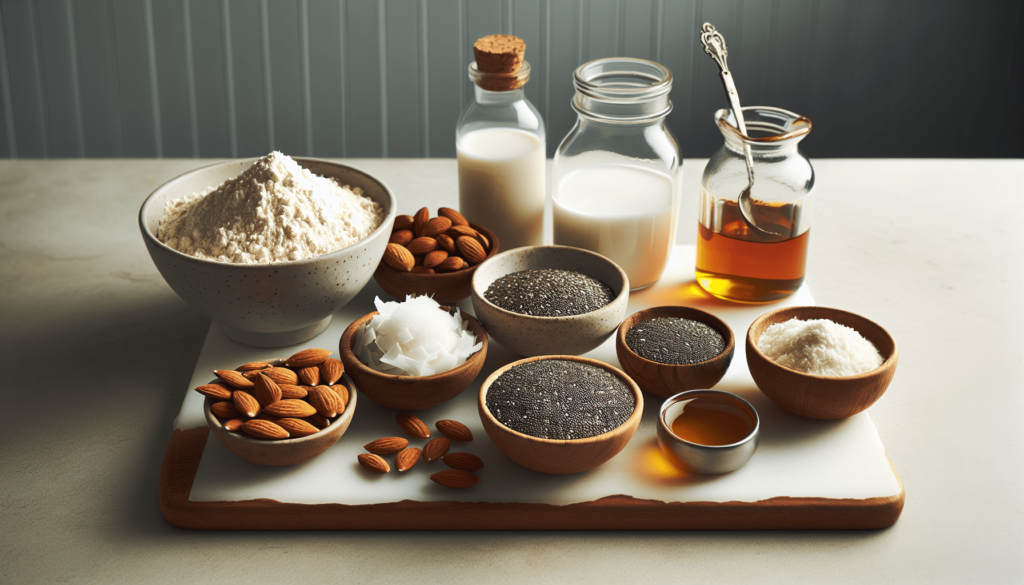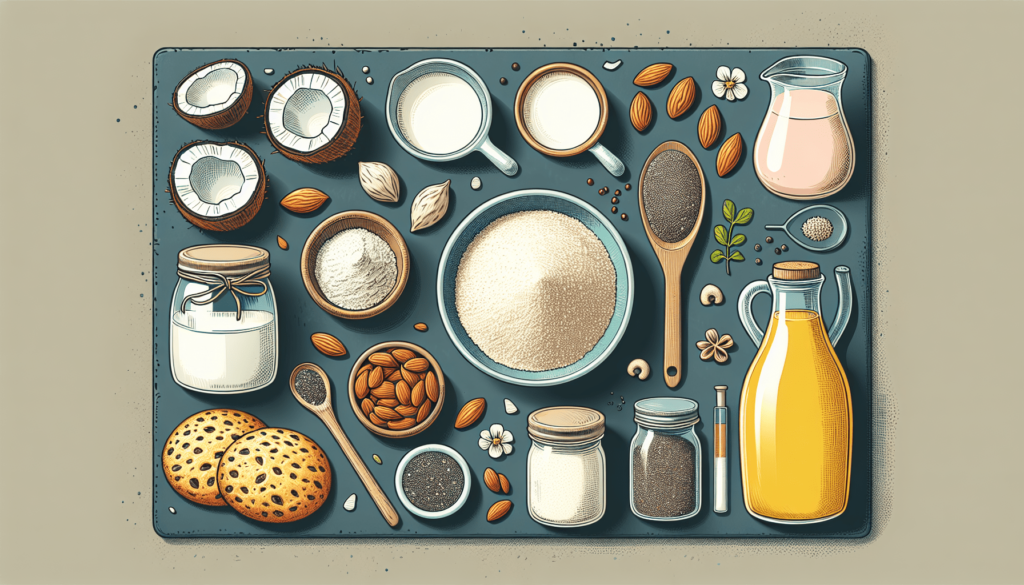In a world where food allergies are increasingly common, navigating the kitchen can seem daunting. “Most Popular Allergen-Free Substitutes for Cooking and Baking” is your go-to guide for creating delicious, safe meals without common allergens. You’ll discover easy swaps for everyday ingredients, allowing you to whip up everything from fluffy pancakes to decadent desserts with peace of mind. Whether you’re cooking for yourself or a loved one, these tips make it simple to keep everyone at the table happy and healthy. Have you ever found yourself in the kitchen, ready to whip up a scrumptious meal or bake a delightful treat, only to realize that you or someone you’re cooking for has a food allergy? Don’t worry—you’re not alone! Many people face the challenge of avoiding certain ingredients due to allergies, but that doesn’t mean you have to compromise on taste or texture. With the right allergen-free substitutes, you can still enjoy your favorite dishes without any worry.
Most Popular Allergen-Free Substitutes for Cooking and Baking
In this guide, we’ll explore some of the most popular allergen-free substitutes for common ingredients in cooking and baking. These alternatives are not only safe but also almost as delicious, if not more so, than their standard counterparts.
Substitutes for Common Allergens
Let’s start by identifying the common allergens and their respective substitutes for cooking and baking.
Dairy Substitutes
Milk, cheese, and butter are staples in many recipes, but they are also common allergens. Here are some alternatives that you can use in your cooking and baking:
-
Milk Alternatives
- Almond Milk: A light, nutty flavor perfect for cereals, smoothies, and even baked goods.
- Soy Milk: Creamier than almond milk, suitable for sauces and baking.
- Oat Milk: Thicker and with a slightly sweet taste, great for coffee or cooking.
- Coconut Milk: Adds a tropical flavor, excellent for curries and desserts.
Table: Milk Alternatives
Standard Milk Substitute Notes Cow’s Milk Almond Milk Light and nutty flavor, good for cereals. Cow’s Milk Soy Milk Creamier, suitable for sauces and baking. Cow’s Milk Oat Milk Thicker with sweet taste, good for coffee. Cow’s Milk Coconut Milk Tropical flavor, great for curries and desserts -
Cheese Alternatives
- Nutritional Yeast: A cheesy flavor perfect for pasta dishes and popcorn.
- Dairy-Free Cheese: Available in many forms like shredded, sliced, or blocks, made usually from nuts or soy.
Table: Cheese Alternatives
Standard Cheese Substitute Notes Cow’s Milk Cheese Nutritional Yeast Cheesy flavor, good for pasta and popcorn. Cow’s Milk Cheese Dairy-Free Cheese Made from nuts or soy, available in multiple forms. -
Butter Alternatives
- Coconut Oil: Works well in baking and cooking, offers a subtle coconut flavor.
- Olive Oil: Great for savory dishes, less effective in baking.
- Avocado: Pureed avocado can work in baking for added creaminess.
Table: Butter Alternatives
Standard Butter Substitute Notes Dairy Butter Coconut Oil Subtle coconut flavor, good for baking/cooking. Dairy Butter Olive Oil Better for savory dishes. Dairy Butter Avocado Adds creaminess, good for baking.
Egg Substitutes
Eggs are multifunctional in recipes, serving as binders, leavening agents, and more. Here are some efficient substitutes:
-
Flaxseed Meal
- Mix 1 tablespoon of flaxseed meal with 3 tablespoons of water for each egg.
-
Applesauce
- 1/4 cup of unsweetened applesauce can replace one egg.
-
Banana
- Half a mashed banana works as a binding agent.
Table: Egg Substitutes
Standard Egg Substitute Notes Egg Flaxseed Meal 1 tbsp flaxseed + 3 tbsp water per egg Egg Applesauce 1/4 cup per egg Egg Banana 1/2 mashed banana per egg
Gluten Substitutes
For those with gluten intolerance or celiac disease, substituting traditional flour is essential. The following are great options:
-
Almond Flour
- Adds a nutty flavor and texture.
-
Coconut Flour
- Absorbs more liquid, so adjust your recipes accordingly.
-
Rice Flour
- Commonly used, with a neutral flavor.
-
Tapioca Flour
- Offers a soft texture, good for thickening.
Table: Flour Substitutes
Standard Flour Substitute Notes Wheat Flour Almond Flour Nutty flavor, adjust for moisture Wheat Flour Coconut Flour Absorbs more liquid, adjust recipe Wheat Flour Rice Flour Neutral flavor, commonly used Wheat Flour Tapioca Flour Soft texture, good for thickening
Nut Substitutes
For those with nut allergies, the following substitutes can often work well:
-
Sunflower Seed Butter
- A creamy substitute for nut butters.
-
Pumpkin Seeds
- Can be used in granolas, salads, or baking.
-
Soy Nuts
- Excellent for snacks or in cooking.
Table: Nut Substitutes
Standard Nut Substitute Notes Almonds, Peanuts Sunflower Seed Butter Creamy, similar to nut butters Chopped Nuts (general) Pumpkin Seeds Can be used in granolas, salads, or baking Roasted Nuts Soy Nuts Great for snacking or cooking
Soy Substitutes
Avoiding soy can be tricky since it’s prevalent in many foods. Here are substitutes you can use:
-
Coconut Aminos
- A direct substitute for soy sauce with a sweet-salty flavor.
-
Sunflower Lecithin
- Used in baking as an emulsifier.
-
Hemp Tofu
- A soy-free tofu alternative.
Table: Soy Substitutes
Standard Soy Product Substitute Notes Soy Sauce Coconut Aminos Sweet-salty flavor, direct substitute Soy Lecithin Sunflower Lecithin Used in baking, as an emulsifier Tofu Hemp Tofu Soy-free tofu alternative
Fish and Shellfish Substitutes
Substituting fish and shellfish can be challenging, but there are vegan and plant-based alternatives:
-
Hearts of Palm
- Mimics the texture of crab in dishes like crab cakes.
-
Jackfruit
- Great for mimicking fish texture in tacos and sandwiches.
-
Seaweed
- Adds a fishy flavor to soups and broths.
Table: Fish and Shellfish Substitutes
Standard Fish/Shellfish Substitute Notes Crab Hearts of Palm Mimics texture, great for crab cakes Fish (general) Jackfruit Good for fish tacos and sandwiches Fish flavoring Seaweed Adds fishy flavor to soups and broths
Enhance Your Allergy-Free Cooking
Understanding and utilizing substitutes is the first step. Here are some additional tips to enhance your allergen-free cooking and baking:
Experiment with Flavors
Flavor is key to any delicious dish. When you’re using substitutes, don’t hesitate to experiment with herbs, spices, and other flavor enhancers:
- Herbs and Spices: Fresh herbs and a variety of spices can dramatically improve the flavor of your dishes.
- Acids: A squeeze of lemon or a splash of vinegar can brighten up a dish.
- Natural Sweeteners: Honey, maple syrup, and agave are great for adding sweetness without allergens.
Adjust Texture
Textural changes are common when using allergen-free ingredients. Adjust your recipes to maintain the desired texture:
- Binding Agents: If your dish is falling apart, ingredients like chia seeds, flaxseeds, or xanthan gum can help hold it together.
- Leavening Agents: Baking without eggs or traditional flour might need additional leavening agents like baking soda or cream of tartar.
Proper Measurements
Substitutes often require different proportions than their traditional counterparts. Carefully measure your ingredients to maintain balance:
- Liquid Ratios: Flour substitutes like coconut and almond flour may need more liquid.
- Fat Content: Dairy-free substitutes often have different fat contents, so you might need to tweak amounts.

Allergen-Free Recipe Suggestions
Now that you’re familiar with allergen-free substitutes, let’s put this knowledge into practice with some easy recipes.
Dairy-Free Mac and Cheese
Ingredients:
- 8 oz gluten-free pasta
- 1 cup unsweetened almond milk
- 1/2 cup nutritional yeast
- 1/4 cup dairy-free butter
- 1/4 cup gluten-free flour (like rice or almond flour)
- Salt and pepper to taste
Instructions:
- Cook pasta according to package directions.
- In a saucepan, melt dairy-free butter over medium heat, then whisk in flour to create a roux.
- Gradually add almond milk, whisking continuously until the mixture thickens.
- Stir in nutritional yeast, salt, and pepper until smooth.
- Combine pasta with the sauce and serve.
Gluten-Free Banana Bread
Ingredients:
- 2 cups almond flour
- 3 ripe bananas, mashed
- 2 eggs or flaxseed meal equivalent
- 1/4 cup honey or maple syrup
- 1 tsp baking soda
- 1 tsp vanilla extract
- 1/4 tsp salt
Instructions:
- Preheat oven to 350°F (175°C). Grease a loaf pan.
- In a bowl, combine mashed bananas, eggs (or flaxseed mixture), honey, and vanilla extract.
- Add almond flour, baking soda, and salt to the wet ingredients and mix until combined.
- Pour the batter into the loaf pan and bake for 45-50 minutes, or until a toothpick comes out clean.
- Cool before slicing.
Egg-Free Pancakes
Ingredients:
- 1 cup oat milk
- 1 tbsp apple cider vinegar
- 1 cup gluten-free flour
- 2 tbsp coconut sugar
- 1 tbsp baking powder
- 1/4 tsp salt
- 2 tbsp melted coconut oil
Instructions:
- Mix oat milk and apple cider vinegar and let sit for 5 minutes to create a “buttermilk” substitute.
- In a large bowl, whisk together the flour, coconut sugar, baking powder, and salt.
- Stir in the “buttermilk” mixture and melted coconut oil until batter is smooth.
- Heat a non-stick pan over medium heat and pour in the batter to form pancakes.
- Cook until bubbles form and edges look set, then flip and cook the other side until golden brown. Serve warm.
Conclusion
Cooking and baking allergen-free can seem daunting at first, but with the right substitutes and a little creativity, you can make delicious meals and treats that everyone can enjoy. Always keep experimenting with new ingredients and techniques to find what works best for you. Whether you’re dealing with dairy, gluten, nuts, or any other allergen, there’s a world of options out there. Happy cooking!

